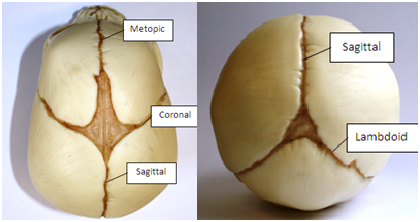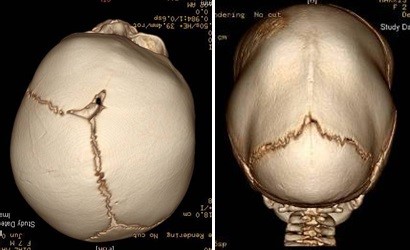
The word synostosis means that a joint has fused into a single bone, which naturally occurs over time in all the long bones at the growth plates. The sutures or seams between the plates in the skull are open to begin with and remain flexible to allow growth throughout childhood, adolescence and into early adulthood, until later in life, when fusion occurs.
Occasionally, one or more joints in the skull can fuse too early, usually during development in the womb. This is called craniosynostosis, and if not managed properly, it will cause deformity and can affect the growth of the brain. The condition can also be associated with developmental deficiencies, some of which are serious, so it’s important to understand the difference between plagiocephaly and craniosynostosis.
Please note that the information provided here is no substitute for diagnosis by a qualified healthcare professional. If you are in any doubt whatsoever as to the nature of your child’s head shape deformity, consult your baby’s GP.
Plagiocephaly vs Craniosynostosis
Plagiocephaly:
Plagiocephaly is a common head shape deformity caused by external pressures on the skull and manifesting in a flat head shape. Craniosynostosis is rarer, affecting about one in 100 infants who develop a severe head shape deformity.
Plagiocephaly can appear for a number of reasons, such as crowding in the womb, breech birth and a lot of time spent lying in the supine position (i.e. on the back) during the early years of life. If caught early on, mild plagiocephaly can be managed successfully towards a full correction, either through repositioning or, in moderate and severe cases, by means of a custom made helmet. Without management, it can result in a lifelong deformity. There are no reported serious effects on development but parents are concerned about the psycho-social issues of such a deformity.
Craniosynostosis:
Contrasting to plagiocephaly, craniosynostosis involves the premature fusion of one or more of the sutures between the bony plates that make up a baby’s skull. This prevents the skull from being able to develop normally within its casing and can inhibit the growth of the brain. To find out more about craniosynostosis including what it is, it’s causes and the varying types, please read our dedicated craniosynostosis page to find out all you need to know.
How can Craniosynostosis be Treated?
The only way craniosynostosis can be managed is through surgery, by reopening the suture that has closed too early. If there is a residual deformity once this has been done, this can be corrected using a cranial remoulding helmet.

Normal Scull Structures

There are some units in Europe and the USA that take a gentle approach, using minimally invasive surgery followed up by treatment with a remoulding helmet. The surgeons who do this work find that the infant has a reduced anaesthetic time, reduced blood loss and a shorter time in hospital. The overall treatment time is longer as the head needs to gently grow back into shape, but the results are equivalent or better than with traditional surgery.
How to Tell the Difference Between Plagiocephaly and Craniosynostosis
The difference between plagiocephaly and craniosynostosis can be very difficult to tell apart visually, and you should by no means treat the information provided here as a diagnostic tool.
However, the key signs to look out for that distinguish craniosynostosis form plagiocephaly, as indicated by the NHS, include:
- A hard ridge along the sutures
- Disproportionate growth of the head compared to the rest of the body
- The fontanelles (soft spots between the bone plates) may feel different or seem to have disappeared
Intercranial pressure (ICP) is another common symptom, which may not become noticeable until an infant reaches 4 – 8 years of age. This is the pressure that builds up in the brain as a result of the irregular shape of the skull and can manifest in persistent headaches, visual problems and an unexplained decline in the child’s academic abilities.
Left untreated, ICP can cause vomiting, irritability, unresponsiveness, swollen eyes and difficulties breathing and hearing, so it’s important to take your child for a check-up if you notice that something is amiss.
Craniosynostosis Diagnosis and Treatment
If you see us for an assessment and the head shape is typical of synostosis, we will not treat but refer you to your own doctor to seek investigation and if necessary, appropriate treatment. In terms of craniosynostosis treatment Technology in Motion are there to provide you with a post-surgery cranial remoulding helmet, should your child need to have an endoscopic strip craniectomy or craniotomy, to help the head shape to develop without abnormality following surgery.
Rest assured, the vast majority of the infants that we see do not have synostosis and achieve an excellent result from our treatment.
Our overriding concern is to ensure that all infants that we treat are treated appropriately and with the utmost care. If you are at all uncertain about the cause of your child’s head shape deformity, contact us for a free check-up and our expert Orthotists will be able to help you.
Call 0330 100 1800 or book an appointment at your nearest clinic, or discover more about what we do here at Technology in Motion and the service that we offer.


